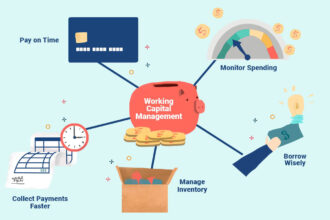Research By: Gouri Malik
Understanding the financial health of a business is crucial for both entrepreneurs and investors. One of the key indicators of a company’s operational efficiency and short-term financial stability is its working capital, also called net working capital (NWC).
In this guide, we’ll break down what working capital is, why it matters, and how it affects a business in a simple, straightforward way.
What is Working Capital?
At its core, working capital is the money a business needs to cover its day-to-day expenses. It is like the fuel that keeps the business’s engine running. Without enough working capital, even a profitable business can struggle to pay its bills and keep operations going smoothly.
Working capital is calculated using the following formula:
Working Capital = Current Assets – Current Liabilities
Here:
- Current Assets are assets that can be converted into cash within a year, such as cash, accounts receivable (money owed by customers), and inventory.
- Current Liabilities are obligations the business must settle within a year, such as accounts payable (money the business owes to suppliers), short-term loans, and other upcoming payments.
For example,
Current Assets:
Cash = ₹20,000
Accounts Receivable = 15,000
Inventories = 45,000
Total = ₹80,000
Current Liabilities:
Accounts Payable = ₹ 25,000
Short term Borrowings = 5,000
Accrued Liabilities = 10,000
Total = ₹40,000
Working Capital = ₹ (80,000 – 40,000) = ₹40,000
Positive v/s Negative Working Capital
If a business has more current assets than current liabilities, it has positive working capital, meaning it has more space for growth in the short term and can easily cover its short term obligations.
But if current assets fall behind current liabilities, then the business has negative working capital and it may face difficulties in growth, meeting its short term obligations and even avoiding bankruptcy.

Working Capital Cycle
The working capital cycle (WCC) represents the time it takes for a company to convert its net current assets and liabilities into cash. The shorter the cycle, the more efficiently a company is managing its working capital by quickly converting its investments into cash and enhancing liquidity.
The cycle consists of three main stages:
- Inventory Period: The time it takes to sell the inventory.
- Receivables Period: The time it takes to collect cash from customers.
- Payables Period: The time the company takes to pay its suppliers.
The formula for the working capital cycle is:
WCC = Inventory Period + Receivables Period − Payables Period
A well-managed working capital cycle indicates that the company is efficiently converting its investments into cash flows. For example, a company that quickly collects receivables and manages its inventory effectively can maintain a healthy working capital balance while optimizing profitability.
Assessing Efficiency and Financial Health
Investors should assess working capital in conjunction with other financial metrics to get a comprehensive view of a company’s health.
- WC for Financial Ratios
Metrics such as the current ratio (current assets divided by current liabilities) and the quick ratio (current assets minus inventory divided by current liabilities) provide additional insights into a company’s liquidity and operational efficiency.
- WC for driving Free Cash Flows
In financial analysis and equity investing, understanding the nuances of working capital and its impact on free cash flows is crucial for accurate valuation and investment decisions.
The working capital cycle represents the time it takes for a company to convert its net working capital into revenue. A significant reduction in the working capital cycle—achieved through initiatives such as improved inventory management, accelerated receivables collection, and extended payables—can enhance a company’s operational efficiency. This efficiency directly influences free cash flows (FCF), which are a critical metric for assessing a company’s financial health and investment potential.
Free cash flow is calculated as operating cash flow minus capital expenditures. When a business effectively reduces its working capital cycle, it can convert its sales into cash more quickly, thereby increasing its operating cash flow. Furthermore, a higher asset turnover ratio—achieved by generating more revenue per unit of assets—complements this by maximizing the efficiency of asset use. Both factors contribute to a substantial increase in free cash flows, often outpacing growth in profits and net assets.
Working capital requirements can vary significantly across industries
Working capital requirements differ across industries due to varying operational cycles and asset structures.
For instance, a manufacturing company might require substantial working capital to finance inventory and raw materials over a longer production cycle. In contrast, a service-based firm, like a consulting agency, has minimal inventory and quicker receivables, reducing its working capital needs.
Working capital management

Improving or Managing working capital is crucial for maintaining a company’s liquidity and operational efficiency. Here are key strategies:
- Optimizing Inventory Levels
Maintain the right balance of inventory to avoid excess stock, which ties up cash, and shortages that can disrupt operations.
- Accelerating Receivables
Implement stricter credit policies and offer discounts for early payments to speed up cash collection from customers.
- Extending Payables
Negotiate longer payment terms with suppliers without compromising relationships, allowing your company to hold onto cash longer.
- Controlling Operating Costs
Regularly review and reduce unnecessary expenses to ensure that cash flow remains healthy and sufficient to cover short-term obligations.
- Monitoring Cash Flow Regularly
Regular tracking of cash inflows and outflows helps in anticipating shortfalls and making informed financial decisions.






